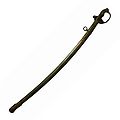- Shin guntō
-
The shin guntō (新軍刀, "New Army Sword") was a weapon and badge of rank used by the Imperial Japanese Army between the years of 1935 and 1945. During most of that period, the swords were manufactured at the Toyokawa Naval Arsenal.
Contents
Creation of a new army sword
Until 1934 the standard sword of the Japanese military was known as the kyū guntō old military sword. The kyū guntō closely resembled European and American swords of the time, with a wraparound hand guard (also known as a D-Guard) and chrome plated scabbard.
In response to rising nationalism within the armed forces, a new style of sword was designed for the Japanese military in 1934. The shin guntō was styled after a traditional slung tachi of the Kamakura period (1185-1332). Officers' ranks were symbolized by coloured tassles tied to a loop at the end of the hilt. The corresponding colors were brown/red & gold General; brown & red field officer; brown & blue company or warrant officer; brown sergeant, sergeant major or corporal.
Type 94
The "type 94" shin guntō (九四式軍刀 kyūyon-shiki guntō) officers sword replaced the western style kyu gunto in 1934. It had a traditionally constructed hilt (tsuka) with ray skin (same) wrapped with traditional silk wrapping (ito). A cherry blossom (a symbol of the Imperial Japanese Army) theme was incorporated into the guard (tsuba), pommels (fuchi and kashira) and ornaments (menuki).
The scabbard (saya) for the Type 94 was made of metal with a wood lining to protect the blade. It was often painted brown and was suspended from two brass mounts, one of which was removable and only used when in full dress uniform. The fittings on the scabbard were also decorated with cherry blossom designs.
The blades found in "Type 94" shin guntō ranged from modern machine made blades through contemporary traditionally manufactured blade to ancestral blades dating back hundreds of years.
Type 95
The "type 95" shin guntō (九五式軍刀 Kyuugō-shiki guntō) released in 1935 was designed for use by non-commissioned officers (NCOs). It was designed to resemble an officer's shin guntō but be cheaper to mass produce. All NCO swords had machine made blades with deep fullers (bo hi) and a serial number stamped on the blade in arabic numerals. Initially the hilts (tsuka) were cast out of metal (either copper or aluminum) and painted to resemble the traditionally produced items on the officer's swords. They had brass guards similar to the officer's shin guntō.
By 1945 a simplified NCO sword was being produced. It had a simple wooden hilt with cross hatched grooves for grip. The scabbards were made from wood instead of metal and the guard and other fittings were made from iron instead of brass.
Type 98
The change to the "type 98" shin guntō (九八式軍刀 Kyuuhachi-shiki guntō) occurred in 1938 and was essentially a simplification of the "Type 94". There were only minor differences between early "Type 98" swords and the "Type 94" swords that preceded them. Most notably the second (removable) hanging point was deleted from the scabbard.
Many changes occurred to the "Type 98" between 1938 and the end of the war in 1945. Late in the war Japan's supply of metal was drying up and shin guntō were produced with painted wooden scabbards, and with cheaper or no brass ornamentation. Some of the final swords produced in the last year of the war utilized cheap copper or blackened iron fittings.
Gallery
-
Type 95 Non Commissioned Officers katana, with a cast metal painted hilt designed to look like a traditionally wrapped tsuka.
See also
List of weapons of the Japanese Empire during World War II
Construction Smithing · Polishing · MountingsSwords & daggers Polearms Practice weapons Glossary · Category · National Treasure swordsJapanese Infantry Weapons of World War IIHistory Firearms of JapanSwords Shin GuntōBayonets Side Arms Rifles / Carbines Type 30 · Type 38 · Type 38 Carbine · Type 44 Carbine · Type 97 sniper rifle · Type 99 · Type 99 sniper rifle · TERA rifle · Type 4 Automatic Rifle · Type ISubmachine Guns Light Machine Guns Heavy Machine Guns Grenades Support Weapons Type 93 Flamethrower · Type 100 Flamethrower · Type 10 Grenade Discharger · Type 89 Grenade Discharger · Type 100 Grenade Discharger · Type 2 Rifle Grenade Launcher · Type 97 20mm AT Rifle · Type 4 70mm AT Rocket LauncherCartridges 9mm Japanese · 8×22mm Nambu · 7×20mm Nambu · 6.5×50mm Arisaka · 7.7×58mm Arisaka · 7.7×58mmSR Arisaka Semi-RimmedCategories:- World War II Japanese infantry weapons
- Japanese sword types
- Blade weapons
Wikimedia Foundation. 2010.



